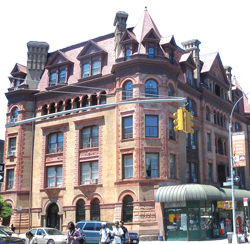1930: Chrysler Building tops off without fatalities
The Chrysler Building reached its full height of 1,030 feet without any fatal injuries, the New York Times reported 87 years ago this month. The $20 million building became the tallest in the world, handily beating out the 792-foot-tall Woolworth Building, which had previously held that title. “It is the first time that any structure in the world has reached such a height…without loss of life,” wrote Walter P. Chrysler, the president of the W.P. Chrysler Building Corporation, in a letter addressed to the Building Trades Employers’ Association. The safety practices on the Midtown building had recently been endorsed by the association. All told, 3,000 workers were involved in the construction. The Art Deco-style skyscraper was designed by American architect William Van Alen and originally startled the architectural community, with critics saying it would “never make sense” and describing Van Alen as the “Ziegfeld of his profession.” The building would remain the tallest for only nine months. In 1931, it was exceeded by the Empire State Building.
1967: Days for Old Met OPERA House numbered as Court upholds ruling
The Court of Appeals in Albany upheld a ruling 50 years ago this month that paved the way for the demolition of the old Metropolitan Opera House on 39th Street and Broadway, according to the New York Times. In the ruling, the court said that a state law aimed at saving the old opera house was unconstitutional. The opera company had been relocated the previous summer to the newly built $47.5 million Lincoln Center, which had a larger seating capacity. The Metropolitan Opera Association, the owner of the old house, had leased the site to developer Keystone Association. The plans called for demolishing the opera house for a 40-story office building. Preservationists and trustees of the Old Met Opera House Corporation fought the demotion. In a last-ditch effort to save the building, then-U.S. Senator Robert F. Kennedy wrote a strongly worded letter that month, calling the destruction of the landmark “incomprehensible.” Just 10 days later, demolition occurred. During the process, protesters gathered at the stage door and lined the sidewalks even as sledgehammers were raining d own on the building’s roof, the Times reported.
1997: Renovation of Bed-Stuy landmark is dealt a setback

The Alhambra Apartments
A developer trying to restore the landmark Alhambra Apartments in Bedford-Stuyvesant was having difficulty securing financing for its $4.25 million redevelopment, the New York Times reported 20 years ago this month. Tom Anderson, a developer who had previously completed restoration projects in Brooklyn, said he had been turned down by the city and state for a low-interest loan. In his “Streetscapes” column, architectural historian Christopher Gray wrote, “The Alhambra apartment house is probably good enough to be called Brooklyn’s Dakota.” Designed by architect Montrose Morris, the building was built in 1889 and became home to a range of middle-class Brooklynites. It featured croquet grounds, a tennis court, frescoes and stained-glass windows. In 1986, the building was landmarked. By 1997 it was in serious disrepair, having suffered a fire a few years prior. Anderson’s plan was to restore and renovate the building into 46 units of low- and moderate-income housing. The cost, he told the Times, would come out to $95,000 per unit. “Right now, as the biggest booster of the Alhambra, I’m very discouraged,” he said of his loan denial. Despite the financing snag, Anderson eventually did complete the renovation project. It was cited in another “Streetscapes“ column 10 years later.
